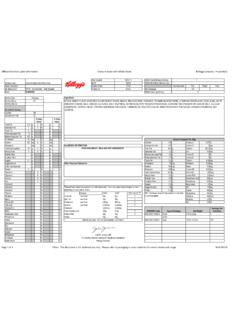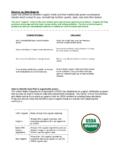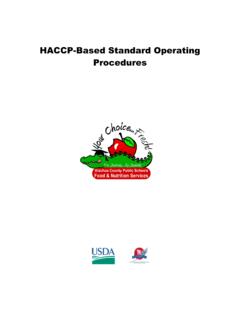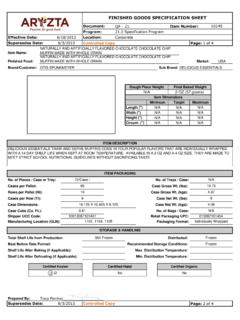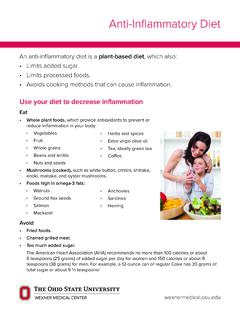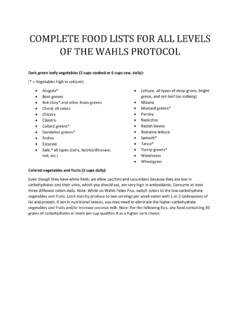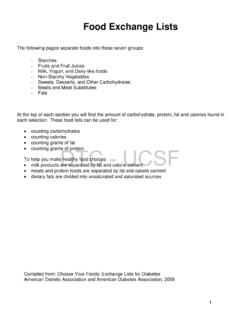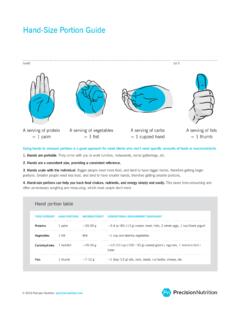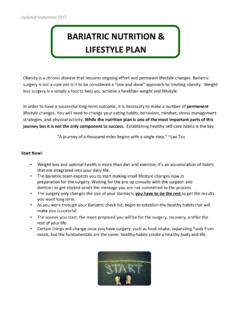Transcription of Carbohydrate Counting Handbook - LINQ
1 Carbohydrate Counting Handbook Table of Contents Page Introduction 2. Why count carbohydrates? 2. Healthy Eating Guidelines ..2. Is this food a Carbohydrate , protein , or fat? .3. Diabetic Food Guide Pyramid .4. Reading Food Labels ..5. Measuring Serving Sizes . 6. Sources of Carbohydrate .7-8. Sources of protein /Fat ..9. Sugar-free versus Carbohydrate -free 10. Snacks 11. Free Foods .12. Low Carb Foods 13. Guidelines for Dining Out 14. Fast Food Facts .. 15-16. Exercise Guidelines . 17-18. Heart Healthy Low-Fat Diet Guidelines 19-20. Sick Day Guidelines . 21. Sources of Carbohydrate Quiz .. 22. Sources of Carbohydrate Quiz (Answer Key) ..23. Meal Planning Quiz .. 24. Meal Planning Quiz (Answer Key) .. 25. Your Carbohydrate Meal Plan 26. Keeping a Food Diary .. 27. Important Phone Numbers .. 28. Carbohydrate Counting Resources 29. Additional Resources to Help You ..30. Introduction The eating regimen for someone with diabetes is a healthy way of eating from which the entire family can benefit.
2 This Handbook will provide you with the basic survival skills to count carbohydrates while eating a healthy diet. Why Count Carbohydrates??? Food is made up of many different nutrients: Carbohydrate protein Fat Vitamins and minerals Water Fiber Our bodies need a little bit of each of these nutrients. But, when someone has diabetes they need to pay close attention to the amount of Carbohydrate that they consume. Carbohydrate is the nutrient that breaks down to sugar in our bodies as we digest it. Our bodies use Carbohydrate for energy. In order to utilize that energy, however, insulin must be available to carry sugar (glucose) into cells. Because people with diabetes have impaired insulin production and/or utilization, sugar can build up in their blood, causing hyperglycemia, if they take in too much Carbohydrate at one time. This is why it is very important to count the grams of Carbohydrate in the foods that you eat. It will allow you to control your diabetes better by eating the correct amount of carbohydrates for the amount of insulin that your doctor prescribes.
3 Carbohydrates and insulin are a balancing act. Healthy Eating Guidelines Guidelines for meal planning: Eat a variety of foods to make sure your diet is well balanced. Limit intake of sweets, fats, and salt to make your diet healthier. Increase intake of fiber. Eat meals and snacks at the same time each day. Eat the same amount of carbohydrates at meals and snacks. 2. Is this food a Carbohydrate , protein , or fat? Now that you will be Counting carbohydrates, you will need to determine if the food that you are eating contains carbohydrates. If any food contains more than 5 grams of Carbohydrate per serving you will need to include it in your meal plan. Foods can be a combination of Carbohydrate , protein , and/or fat . You can use the food guide pyramid to help you determine if a food is a Carbohydrate , protein , or fat, or a combination. Carbohydrate Group: Grains, dried beans, starchy vegetables Fruit Milk & yogurt protein Group: Beef, pork, poultry, fish Eggs, cheese Nuts Tofu Fat Group: Butter Margarine Oils Lard Sour cream Mayonnaise Salad dressings* (see page 9 ).
4 3. Diabetic Food Guide Pyramid 4. Reading Food Labels There are two steps to follow when reading food labels to count carbohydrates: 1. Look at the serving size for the food. This is located at the top of the label. 2. Look at the total Carbohydrate amount. This is located towards the middle of the label. These two parts of the label tell you what you need to know. The amount of total carbohydrates listed is for the particular serving size listed. Also keep the following information in mind when reading food labels: Sugars reflect both added sugars and those that naturally occur in foods. It is important to look at the total amount of Carbohydrate rather than the source. If sugar alcohols are listed on the food label, divide that number by 2 and subtract it from the total Carbohydrate . (Sugar alcohols only provide half the calories as sugar.). If dietary fiber is listed on the food label, you can subtract the full amount of fiber from the total Carbohydrate .
5 (Fiber is not digested as sugar and therefore, will not have an effect on our blood sugar.). 5. Measuring Serving Sizes Measuring the serving size of the items that you are choosing to eat is very important. The total amount of carbohydrates depends on the serving size. Therefore, it is very important that you have measuring cups, spoons, and/or a food scale. The following is a list of descriptions to help you visualize what a serving size might look like, in case measuring cups are not available. Easy Ways to Estimate Portion Size 3 oz boneless meat = deck of cards 1 oz slice cheese = 3 computer disk Medium piece of fruit = baseball or tennis ball 2 Tbsp peanut butter = golf ball cup dried fruit = golf ball 1 pancake = compact disk (CD). 1 serving of chips (1 oz) = 1 small cupped hand 6. Sources of Carbohydrate Each item listed with its accompanying serving size contains about 15 grams of Carbohydrate or 1 serving(exchange) of Carbohydrate .
6 Breads starchy Vegetables 1 slice bread cup corn 2 slices reduced-calorie bread 1 corn on cob, 6-inch 1 1oz. dinner roll cup peas hamburger/hot dog bun 1 3oz potato, plain (baked or boiled). bagel cup mashed potatoes English muffin cup yam, sweet potato, plain 1 2 -inch biscuit 1 cup squash, winter (acorn, butternut). 1 2-inch cube cornbread 1/3 1/2 cup tomato or spaghetti sauce 6-inch pita 1 cup vegetable juice 1 6-inch tortilla 2 6-inch taco shells Beans, Peas, and Lentils 1 4 -inch waffle 1/3 cup baked beans 2 4-inch pancakes cup beans/peas, cooked (garbanzo, 1 slice French toast pinto, kidney, white, split, black-eyed). 1 cup croutons 2/3 cup lima beans 1/3 cup stuffing, bread (prepared) cup lentils, cooked Cereals and Grains Crackers and Snacks cereal bar 7 saltine crackers unfrosted poptart or toaster pastry 15-20 tortilla or potato chips cup bran cereal 24 oyster crackers cup unsweetened cereal 8 animal crackers cup sugar-frosted cereal 3 2- -inch square graham crackers 1 cup puffed cereal oz pretzels cup Shredded Wheat - soft pretzel cup Grape-Nuts 3 cups popped popcorn cup oats 2 4-inch rice cakes cup cooked cereal (grits, oatmeal) cup chow mein noodles 1/3 cup couscous 3 cheese or peanut butter crackers 3 Tbsp flour (dry) 43 Goldfish crackers 3 Tbsp cornmeal (dry) 21 Cheese Nips.
7 3 Tbsp wheat germ cup pasta (cooked) Milk and Yogurt 1/3 cup rice (white or brown) (cooked) 1 cup (8 oz) milk (skim, 1%, 2%, whole). cup rice milk cup (4 oz) chocolate milk cup (6 oz) plain, low-fat yogurt cup evaporated milk 1/3 cup nonfat dry milk 1 cup goat's milk 7. More Sources of Carbohydrate Each item listed with its accompanying serving size contains about 15 grams of Carbohydrate or 1 serving(exchange) of Carbohydrate . Fruit Combination/Other Food cup canned fruit (unsweetened, in its cup Ice cream own juice) cup Ice cream, no added sugar cup applesauce (unsweetened) 1/3 - 1/2 cup frozen yogurt 1 small banana (4 inch) cup sherbet 1 small apple, orange cup pudding, sugar-free 15 small grapes 1- inch square cake, frosted 1 cup strawberries, whole 2- inch square cake, unfrosted 1 cup watermelon (cubed) Doughnut, plain cake 1 cup cantaloupe, honeydew, papaya 1 Tbsp honey (cubed) 1 Tbsp sugar 2 Tbsp raisins 1 Tbsp regular syrup cup dried fruit 1 Tbsp light syrup cup juice (apple, orange, grapefruit, 1 Tbsp jam, jelly pineapple) 3 Tbsp ketchup 1/3 cup juice (grape, cranberry, prune, cup jello, regular blends) 1/3 1/2 slice, medium pizza Fibrous Vegetables Each item listed contains about 5 grams of Carbohydrate per serving.
8 What is a serving of fibrous vegetables? cup cooked OR 1 cup raw Artichoke/artichoke hearts Mixed vegetables, without corn, peas, pasta Asparagus Mushrooms Beans (green, wax, Italian) Okra Bean sprouts Onions (white, green, scallions). Beets Pea pods Broccoli Peppers, all varieties Brussels sprouts Radishes Cabbage Salad greens Carrots Sauerkraut Cauliflower Spinach Celery Summer squash Cucumber Tomato Eggplant Turnips Greens (collard, kale, mustard, turnip) Water chestnuts Kohlrabi Watercress Leeks Zucchini Lettuce 8. protein /Fat (0 grams Carbohydrate ). Each item listed is considered a protein and/or fat, unless you add Carbohydrate to it Beef Cream cheese Poultry Creamer, non-dairy Fish/Seafood Mayonnaise Pork Margarine Veal Butter Meat sticks Oil Luncheon/deli meats Lard Eggs Salad dressings: **ranch, oil and vinegar, Cheese Caesar Nuts Sour cream **The following are salad dressings that can be high in Carbohydrate per serving. Please read the food label to determine the amount of Carbohydrate : Catalina Russian French Red wine vinaigrette Honey Dijon Raspberry vinaigrette Honey mustard Thousand island Poppy seed **Items that are fat-free, low-fat , lite , or reduced-fat may actually have sugar/ Carbohydrate added to them to make them taste better, since the fat was taken out.
9 Therefore, you should always read the food label for the total Carbohydrate . 9. Sugar-free versus Carbohydrate -free Just because a food is labeled Sugar-Free or No Sugar Added doesn't necessarily make it a free food, it may contain Carbohydrate . The Carbohydrate may come from other ingredients in the food, such as flour. You still need to read the label for the total Carbohydrate and include it in your meal plan. The reason that an item can be labeled Sugar-Free or No Sugar Added is because the manufacturer is not adding table sugar. Sugar comes in many forms other than table sugar. All types of sugar contain Carbohydrate that will affect your blood sugar. Sugar-free means less than grams of table sugar per serving. No added sugar means that no sugar was added, but it may be found naturally in the food. The following is a list of different types of sugar: Nutritive (caloric) sweeteners: Glucose Raw sugar Fructose Corn sweetener Sucrose- table sugar (white sugar) Dextrose Lactose Honey Galactose Molasses Brown sugar High fructose corn syrup Dextrin Corn syrup Maple syrup Sugar Maltose Sugar alcohols- sorbitol, mannitol, xylitol Non-nutritive (low-calorie) sweeteners: The use of these products will help limit sugar intake.
10 Saccharine- Sweet-N-Low . Aspartame- NutraSweet , Equal . Acesulfame K- SweetOne . Sucralose- Splenda . **All are approved by the Food and Drug Administration (FDA). **People with phenylketonuria should not use aspartame. 10. Snacks Snacks are a very important part of your meal plan. For good blood sugar control, you should eat the same amount of Carbohydrate for each snack. When you count carbohydrates, you are given the flexibility to eat what you want at snacks, as long as it fits into your Carbohydrate meal plan. Snacks can contain 15-30 grams of Carbohydrate . Your dietitian will tell you how much to have. You can refer to the lists of sources of Carbohydrate to help you pick and choose what to have or simply read the food label of the item that you want. Bedtime snacks should contain both Carbohydrate and protein . Here are some examples of snacks that contain about 15 grams of Carbohydrate : 1 small piece fresh fruit 3 cups popcorn 6 oz light yogurt 7 saltine crackers w/ cheese cup ice cream cup unsweetened applesauce 2 rice cakes cup sugar-free pudding sandwich Here are some examples of snacks that contain about 30 grams of Carbohydrate : 1 granola bar 1 cereal bar 6 pk crackers 6 cups popcorn 1 small bagel w/ cream cheese 1 sandwich (meat and cheese).
